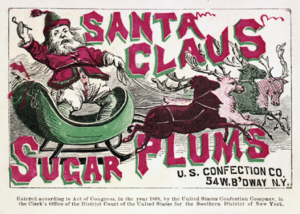Sugar plum facts for kids

Confection label, showing Santa Claus on sleigh with reindeer (1868)
|
|
| Type | Dragée or comfit |
|---|---|
A sugar plum is a type of hard candy. It is usually small, round, or oval-shaped. The name "plum" in sugar plum does not always mean the fruit. Instead, it often describes the candy's small, round shape.
Many traditional sugar plums did not have fruit inside. They were hard sugar balls called comfits. These candies often had a seed, nut, or spice in the middle.
Contents
The Sweet Story of Sugar Plums
Sugar plums have a long and interesting history. People have been making them for hundreds of years!
How Sugar Plums Were Made
In the 16th century, the term "sugar plum" was used for many candied items. This included fruits, nuts, and even roots covered in sugar.
Making sugar plums used to be a very slow process. It was called panning. This method involved adding many thin layers of sugar to create a hard shell. Before machines were invented, this could take several days. Because of all the work, sugar plums were a luxury. Only rich people could usually afford them.
Sugar Plums for Everyone
By the 1860s, things changed. Factories started using steam heat and spinning machines. This made the panning process much faster. Suddenly, sugar plums could be made in large amounts. This meant more people could enjoy these sweet treats!
Modern Sugar Plums
Today, some candy makers create candies that taste like plums. They even make them shaped like plums and call them "sugar plum candy."
You can also find recipes for homemade "sugar plums." These often mix dried fruits and almonds with honey. Spices like anise, fennel, or cardamom are sometimes added. This mixture is then rolled into balls and coated in sugar or shredded coconut.
Sugar Plums in Pop Culture
Sugar plums are very famous around Christmas time. They appear in many popular stories and songs.
The Nutcracker Ballet
One of the most famous connections is the Sugar Plum Fairy. She is a magical character in The Nutcracker ballet. This famous ballet was created by Tchaikovsky in 1892.
A Famous Christmas Poem
Sugar plums are also mentioned in the poem A Visit from St. Nicholas. This poem is better known as "'Twas the Night Before Christmas." It has a famous line: "While visions of sugar plums danced in their heads." This line helps us imagine children dreaming of sweet treats on Christmas Eve.
The Sugar-Plum Tree
Another well-known poem is "The Sugar Plum Tree" by Eugene Field. It starts with the line: "Have you ever heard of the Sugar-Plum Tree? 'Tis a marvel of great renown!" This poem makes sugar plums sound even more magical.
Related pages
- Uapaca kirkiana, a species of plant native to the southern Afrotropics, known as the sugar plum.

